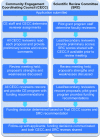Strengthening community involvement in grant review: insights from the Community-University Research Partnership (CURES) pilot review process
- PMID: 24456508
- PMCID: PMC5350939
- DOI: 10.1111/cts.12141
Strengthening community involvement in grant review: insights from the Community-University Research Partnership (CURES) pilot review process
Abstract
In 2007, the Michigan Institute for Clinical and Health Research (MICHR) at the University of Michigan received a Clinical and Translational Science Award (CTSA). Within MICHR, the Community Engagement (CE) program supports partnership efforts between researchers, practitioners, and community-based organizations in specific focal communities throughout Michigan. A key component of the CE program is the Community Engagement Coordinating Council, a group that provides input and guidance on program priorities, strategic planning, and reviews pilot funding proposals for community-academic partnerships. This paper will describe a unique MICHR pilot funding mechanism for Community-University Research Partnerships (CURES) with an emphasis on the ways that community partners are involved in the review process, as well as the benefits, challenges, and insights gained over 5 years of pilot review. There is a growing need for community involvement and expertise in review of funding proposals for community-engaged research at both institutional and federal levels. The CURES pilot review process is one example of an institutional effort to engage community partners in university funding decisions and has demonstrated clear benefit toward accomplishing the aims of the CTSA.
Keywords: Michigan; community-academic partnerships; community-engaged research; grant review; institutional funding; pilot grants.
© 2014 Wiley Periodicals, Inc.
Figures
Similar articles
-
A Community-Academic Partnered Grant Writing Series to Build Infrastructure for Partnered Research.Clin Transl Sci. 2015 Oct;8(5):573-8. doi: 10.1111/cts.12327. Epub 2015 Sep 13. Clin Transl Sci. 2015. PMID: 26365589 Free PMC article.
-
A community translational research pilot grants program to facilitate community--academic partnerships: lessons from Colorado's clinical translational science awards.Prog Community Health Partnersh. 2012 Fall;6(3):381-7. doi: 10.1353/cpr.2012.0036. Prog Community Health Partnersh. 2012. PMID: 22982851 Free PMC article.
-
Health Extension and Clinical and Translational Science: An Innovative Strategy for Community Engagement.J Am Board Fam Med. 2017 Jan 2;30(1):94-99. doi: 10.3122/jabfm.2017.01.160119. J Am Board Fam Med. 2017. PMID: 28062823
-
Experience of King Abdul-Aziz City for science and technology in funding medical research in Saudi Arabia.Saudi Med J. 2004 Jan;25(1 Suppl):S8-12. Saudi Med J. 2004. PMID: 14968184 Review.
-
Evidence of commitment to research partnerships? Results of two web reviews.Health Res Policy Syst. 2019 Jul 30;17(1):73. doi: 10.1186/s12961-019-0475-5. Health Res Policy Syst. 2019. PMID: 31362791 Free PMC article. Review.
Cited by
-
Exploring the potential role of community engagement in evaluating clinical and translational science grant proposals.J Clin Transl Sci. 2018 Jun;2(3):139-146. doi: 10.1017/cts.2018.311. Epub 2018 Sep 18. J Clin Transl Sci. 2018. PMID: 30370066 Free PMC article.
-
What works for peer review and decision-making in research funding: a realist synthesis.Res Integr Peer Rev. 2022 Mar 4;7(1):2. doi: 10.1186/s41073-022-00120-2. Res Integr Peer Rev. 2022. PMID: 35246264 Free PMC article.
-
Mobilizing community-driven health promotion through community granting programs: a rapid systematic review.BMC Public Health. 2024 Apr 1;24(1):932. doi: 10.1186/s12889-024-18443-8. BMC Public Health. 2024. PMID: 38561718 Free PMC article.
-
Improving the Translational Medicine Process: Moving Patients From "End-Users" to "Engaged Collaborators".Front Med (Lausanne). 2019 May 21;6:110. doi: 10.3389/fmed.2019.00110. eCollection 2019. Front Med (Lausanne). 2019. PMID: 31165071 Free PMC article.
-
Building a pipeline of community-engaged researchers: How interdisciplinary translational research training programs can collaborate with their Community Research Advisory Councils.J Clin Transl Sci. 2021 Jul 14;5(1):e156. doi: 10.1017/cts.2021.818. eCollection 2021. J Clin Transl Sci. 2021. PMID: 34527295 Free PMC article.
References
-
- CTSA Community Engagement Key Function Committee and CTSA Community Engagement Workshop Planning Committee . Researchers and their communities: The challenge of meaningful community engagement. Duke University. 2009. Available at: https://ctsacorus.org/resources/273/download/Monograph‐ResearchersTheir_.... Accessed May 13, 2013.
-
- Israel B, Schulz A, Parker E, Becker A. Review of community‐based research: assessing partnership approaches to improve public health. Annu Rev Public Health. 1998; 19(1): 173–202. - PubMed
Publication types
MeSH terms
Grants and funding
LinkOut - more resources
Full Text Sources
Other Literature Sources
Miscellaneous


